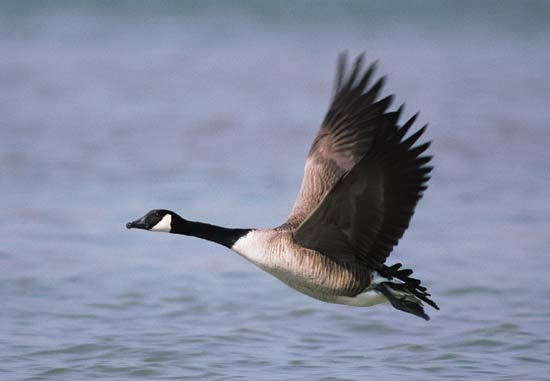goose
bird
 any of various large, heavy-bodied waterfowl intermediate in size and build between large ducks (duck) and the swans (swan), especially those of the genera Anser (so-called gray geese) and Branta (so-called black geese). Associated mainly with freshwater and living in the Northern Hemisphere, these genera include the Canada goose, white-fronted goose, barnacle goose, and snow goose, as well as the brant and nene.
any of various large, heavy-bodied waterfowl intermediate in size and build between large ducks (duck) and the swans (swan), especially those of the genera Anser (so-called gray geese) and Branta (so-called black geese). Associated mainly with freshwater and living in the Northern Hemisphere, these genera include the Canada goose, white-fronted goose, barnacle goose, and snow goose, as well as the brant and nene.The sexes are alike in coloration, though males (ganders) usually are larger than females. The neck is always shorter than the body. The bill (beak) is humped at the base and tapered toward the tip; the plates of the bill are adapted for grasping the sedges and grasses upon which geese feed. The legs are farther forward than in swans and ducks, allowing the bird to walk readily. Both sexes utter loud honking or gabbling cries while on the wing or when danger appears. When angry, geese vibrate their neck feathers; after routing an intruder, the gander utters a triumphant note that is echoed by his mate and young goslings.
Geese pair for life and associate in flocks called gaggles. Simple nests are built on the ground. The rough-surfaced, whitish eggs are incubated for about a month by the hen while the gander stands guard. The downy young fend for themselves almost at once but remain with their parents during the first summer. Geese may survive for 10–15 years in the wild and more than 30 years in captivity.
These migratory birds winter in limited localities far south of their breeding grounds, although Canada geese (Branta canadensis) have become year-round residents of some areas. In migration they are greeted everywhere as harbingers of the changing seasons. Powerful and high fliers, they travel in V-formations to conserve energy by taking advantage of air currents (vortices) created by the wing tips.
Also called geese are a number of waterfowl of gooselike build that live in the Northern and Southern Hemispheres and belong to other groups. Among them are the magpie goose, sheldgoose, perching duck, Cape Barren goose of Australia, (Cereopsis novaehollandiae), African pygmy goose (Nettapus auritus), and the solan goose (see gannet).
board game
French L'oie,
ancient French board game, said to have been derived from the Greeks, which was popular in Europe at the end of the Middle Ages.
Goose was played on a board upon which was drawn a fantastic scroll, called the jardin de l'oie (“goose garden”), divided into 63 spaces marked with certain emblems, such as an inn, a death's head, a bridge, and a labyrinth. The emblem inscribed on spaces 1 and 63, as well as on every ninth space between, was a goose.
The object of the game was to land one's counter on number 63, after a series of moves to unoccupied spaces determined by the throw of two dice. A counter was moved forward, backward, or temporarily stalled, according to the space on which it was placed. Landing on an inn required a wait until two other players had played; landing on a death's head required a player to start over; and landing on a goose doubled the move. The game was usually played for a stake, and special fines were exacted for landing on certain spaces. At the end of the 18th century, a variation of the game was called jeu de la revolution française (“game of the French Revolution”).
- zooxanthella
- Zophar
- Zorach, William
- Zora Neale Hurston
- zorapteran
- zorille
- Zorn, Anders
- Zorn's lemma
- Zoroaster
- Zoroastrianism
- Zorrilla de San Martín, Juan
- Zorrilla y Moral, José
- Zorzor
- Zoshchenko, Mikhail Mikhaylovich
- Zosimus, Saint
- Zouche, Richard
- Zou Yan
- Zouérat
- Zoysia
- Z particle
- Zrínyi, Miklós
- Zsigmond, Baron Kemény
- Zsigmond Kemény, Baron
- Zsigmond Móricz
- Zsigmondy, Richard